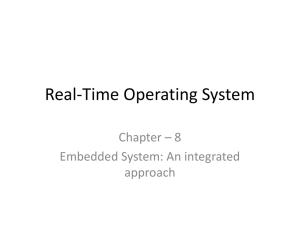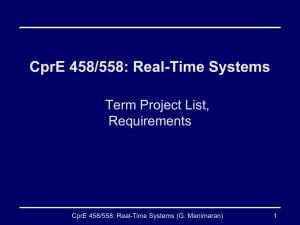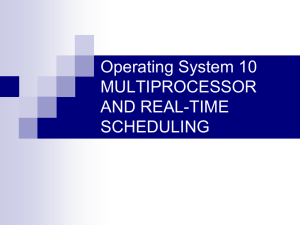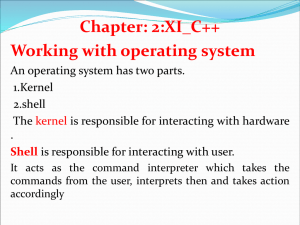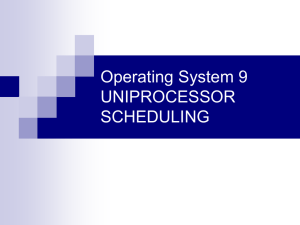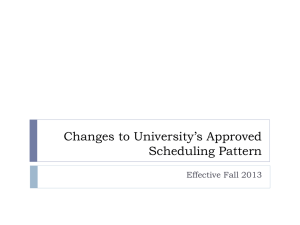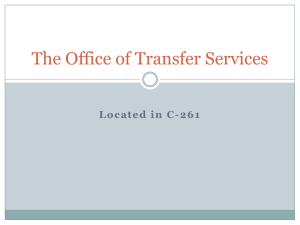9.1_RT-Vocabulary
advertisement
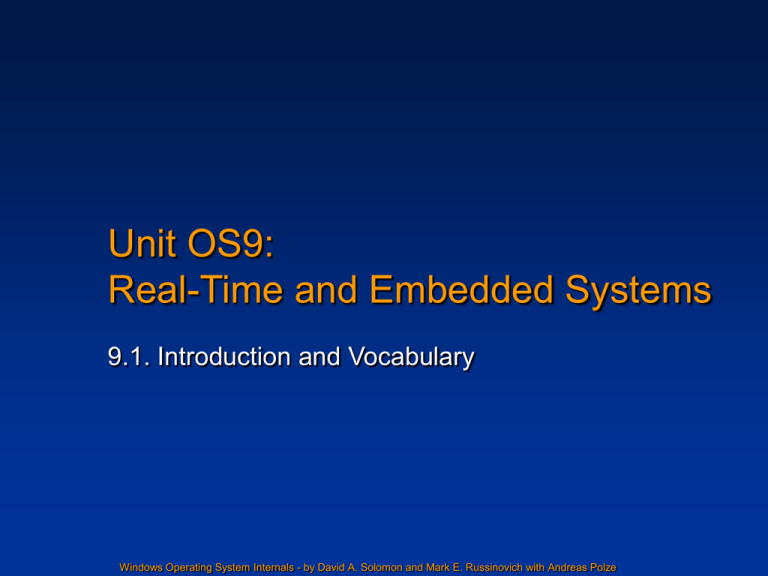
Unit OS9: Real-Time and Embedded Systems 9.1. Introduction and Vocabulary Windows Operating System Internals - by David A. Solomon and Mark E. Russinovich with Andreas Polze Copyright Notice © 2000-2005 David A. Solomon and Mark Russinovich These materials are part of the Windows Operating System Internals Curriculum Development Kit, developed by David A. Solomon and Mark E. Russinovich with Andreas Polze Microsoft has licensed these materials from David Solomon Expert Seminars, Inc. for distribution to academic organizations solely for use in academic environments (and not for commercial use) 2 Roadmap for Section 9.1 Introduction and Vocabulary Performance Measures General Structure of a Real-Time System Task Assignment and Scheduling Uni- vs. Multi-Processor Scheduling Algorithms Critical Sections and Priority Inversion 3 Introduction and Vocabulary What is a Real-time System? “A real-time system is one in which the correctness of the computations not only depends on the logical correctness of the computation, but also on the time at which the result is produced. If the timing constraints of the system are not met, system failure is said to have occurred.” Confusion: Not a clear definition! What are timing constraints ? (tasks have deadlines) 4 More confusion What is the meaning of a “deadline"? Do all tasks have to be executed before their deadline? (not necessarily) Sometimes “yes”: flight control in an aircraft Sometimes “no”: Multimedia-App. What is the meaning of “executed“? How to decide whether a task has been (completely) executed? Relatively simple: bank transaction Impossible: Computation of π How to deal with tasks that missed their deadlines? Terminate or run to completion? Aircraft accident vs. Videoconference 5 Task Value Functions Value Value deadline deadline Value deadline 6 Hard vs. Soft Real-time Systems Hard real-time systems Embedded systems: aircraft control, nuclear power plants, chemical reactors, jet engines Missing a deadline has life-threatening results. Soft real-time systems Multimedia, airline reservation system Missing a deadline is undesirable and impacts system performance but has not destroy lives or equipment. 7 Vocabulary Example: Car & Driver Well-known example for human control: Comparable to a real-time computer system in many respects Driver: real-time controller Car: controlled process Road and additional cars: operating environment Actuators: Wheels, engine, brakes Controls: Steering wheel, brake pedal, switches 8 Mission Statement Drive within the allowed speed range from start A to destination B without collisions with other cars or stationary objects. How can driver‘s performance be measured? Departs from A and reaches destination B Total driving time But: road conditions have to be taken into account What, if driver leaves the road? Success: collision could be avoided Failure: control over vehicle was lost 9 The Mission – a closer look Performance is no absolute measure. Performance measures quality of a result in terms of the best possible result under the current environmental conditions. A closer look onto the mission: Mission critical: steering, brakes Non-critical: radio, lights Deadlines are not constants (rush hour vs. Sunday drive) How to measure the drivers physical condition? 10 Performance Measures Average values say very little about the performance of a real-time controller. In our scenario: How to value abrupt acceleration/deceleration maneuvers ? How to measure for unnecessarily increased fuel usage? What about extra slow driving? 11 Problems of RT Computing Reliability, Fault-tolerance Harsh environments, electromagnetic noise, rapidly changing computation loads Task Scheduling Traditional Approach: fairness / round robin scheduling / time slicing RT System: fixed priority scheduling / generalized rate monotonic scheduling / earliest deadline first Memory Management Swapping / paging Static pre-allocation (mpin(), vm_wire()) 12 Problems of RT Computing (contd.) Cache Allocation Policy Preemption may cause cache invalidation -> missed deadline Does tA = tA1 + tA2 hold? A tA1 B A A preempted A resumed tA2 A completed 13 Structure of a Real-time System Environment Controlled process Sensors Job list Clock Trigger generator Actuators Controller: RT-Computer/ Uni- vs. Multiprocessor Execution Display Operator Input data rates: typically < 1 KB/sec Fixed set of processes; software is "pre-loaded“ Scheduler (offline vs. online schedules) Output data rates: typically < 1 command/25 ms 14 Data Rates Sensors/Actuators/Display/Input Panels: low Data conversion/formatting: medium (peripheral area) Control algorithm: high (central cluster) Sensor and actuator layer Peripheral area Central cluster Controlled process often moves through different phases Varying sets of priorities, control tasks, deadlines 15 Task Classes Periodic, sporadic and aperiodic tasks Critical and non-critical tasks Non-critical real-time (soft real-time tasks): Objective: maximize percentage of jobs successfully executed 16 Areas of Interest Architecture Processor Architecture Network Architecture Architectures for Clock Synchronization Fault-tolerance and Reliability Evaluation Operating System Task Assignment and Scheduling Communication Protocols Failure Management and Recovery Clock Synchronization Algorithms Others Programming Languages Databases Performance Measures 17 Task Assignment and Scheduling Objective: allocation and scheduling of tasks on processors to ensure that deadlines are met Problem statement: Given a set of tasks, task precedence constraints, task characteristics, and deadlines, we are asked to devise a feasible allocation/schedule on a given computer Task consumes resources (cpu, memory, input data) produces results Precedence constraints: Ti needs output from Tj 18 Task Dependency Graph Characteristics: Precedence-relation "<“ Release time Deadline (hard, soft) Relative deadline: absolute deadline - release time 19 Periodicity Periodic: released periodically, every Pi seconds Period Pi Runs once every period (not exactly every Pi sec) Sporadic: not periodic, invoked irregularly Upper bound on invocation rate Aperiodic: sporadic but without bounded invocation rate Example: Sensor is read every 10 ms. If value exceeds threshold, signal is send out Sensor task is periodic; period p = 10ms Task that sends the signal is sporadic Maximum invocation rate for this sporadic task? 20 Feasibility of a Schedule Task assignment/schedule is feasible if all tasks start after their release times and complete before their deadlines Schedule S: Set of processors x Time Set of tasks S(i,t) is the task scheduled to be running on processor i at time t Offline scheduling: precomputed schedule Online scheduling: tasks are scheduled at arrival Must be fast Static-priority algorithms: tasks' priorities do not change within a mode (Rate Monotonic Scheduling - RMS) Dynamic-priority algorithms: priority changes with time (Earliest Deadline First - EDF) 21 Preemptive vs. non-preemptive Scheduling Preemptive: tasks can be interrupted by other tasks More flexible Critical task must be allowed to interrupt less critical ones Non-preemptive: task runs until completion or blocking • S1: sub optimal; non-preemptive • S2: T2 misses deadline; nonpreemptive • S3: preemptive; resource optimal • Overhead for preemption; bookkeeping • Preemption not always possible: disk write 22 Uni-processor Scheduling Traditional rate-monotonic scheduling (RMS) Periodic, preemptable tasks Deadlines equal task period Set of n tasks is schedulable if total processor utilization is no greater than n(2 1/n-1) Task priorities are static; inversely related to periods Optimal static-priority uniprocessor algorithm Some results for deadline ≠ period Rate monotonic deferred server (DS) Similar to RMS Can handle both: periodic and aperiodic tasks 23 Uni-processor Scheduling (contd.) Earliest deadline first (EDF): Tasks are preemptible Task with earliest deadline has highest priority Optimal uni-processor algorithm If a task set is not schedulable on a single processor by EDF, there is no other processor that can successfully schedule that task set Precedence and exclusion conditions: RMS & EDF assume independent preemptible tasks Only processing requirements are taken into account; memory, I/O, other resource requirements negligible 24 Uni-processor Scheduling (contd.) Multiple task versions: System has primary and alternative version of tasks Vary in execution time and quality of output Primary: full-fledged task; top quality output Alternative: bare-bone; lower-quality (acceptable) output; take less much execution time Schedule may pick alternative tasks during overload IRIS tasks (increased reward with increased service): Quality of output is monotonically nondecreasing function of execution time Example: iterative algorithms for computation of π 25 Multiprocessor Scheduling Task assignment problem generally is NP-hard Use heuristics 26 Multiprocessor Scheduling Utilization balancing algorithm: Assigns tasks to processors one by one Balanced utilization at end of each step Preemptive tasks Next-fit algorithm: Works in conjunction with RMS uni-processor algorithm Divides task set into classes Processors are exclusively assigned to tasks Preemptive tasks 27 Multiprocessor Scheduling (contd.) Bin-packing algorithm: Assigns tasks to processors so, that utilization does not exceed given threshold Threshold is set so that uni-processor algorithm is able to schedule assigned tasks Preemptive tasks Myopic offline scheduling algorithm: Deals with non-preemptive tasks Builds schedule using a search process Focused addressing and bidding algorithm: Tasks arrive at individual processors If schedule not feasible: processor may offload some of its workload onto other processors Other processors may voluntarily take over tasks 28 Multiprocessor Scheduling (contd.) Buddy strategy: Three categories: underloaded, fully loaded, and overloaded processors Overloaded processors ask underloaded ones to take over some load Assignment with precedence constraints: Takes precedence constraints into account Trial-and-error process: assign communicating processes onto same processor 29 Scheduling Problems Critical Sections: Source of anomalous behavior: priority inversion Lower-priority tasks can block higher-priority tasks Priority inheritance/priority ceiling protocols: finite upper bound to the period of priority inversion Mode Changes: Mission can have multiple phases Different task sets Different priorities/arrival rates How to add/delete tasks of the task list Fault-Tolerant Scheduling: Schedule backups in the event of failure 30 Critical Sections Binary semaphores Lower priority task may block higher priority task • T3 has lock; blocks T1 • T2 interrupts T3 Priority inversion 31 Priority Inheritance Protocol TIME_CRITICAL TH starts, request resource NORMAL TL locks resource TH continues to completion TL is boosted until it frees resource TL runs as scheduled Time TL blocks TH (by owning a semaphore)... TL inherits temporarily priority of TH Every lower priority task may block higher priority task exactly once per critical section Priority inheritance protocol may create deadlocks 32 Priority Ceiling Protocol Priority ceiling of a semaphore is highest priority of any task that may lock semaphore Priority owner of lock = priority ceiling Critical Section Accessed By Priority Ceiling S1 T1, T2 P(T1) S2 T1, T2, T3 P(T1) S3 T3 P(T3) S4 T2, T3 P(T2) • Priority ceiling protocol prevents deadlocks 33 Requirements for a RT OS The OS (operating system) must be multithreaded and preemptive The OS must support thread priority A system of priority inheritance must exist The OS must support predictable thread synchronization mechanisms In addition, the OS behavior must be predictable. This means real-time system developers must have detailed information about the system interrupt levels, system calls, and timing: The maximum time during which interrupts are masked by the OS and by device drivers must be known. The maximum time that device drivers use to process an interrupt, and specific IRQ information relating to those device drivers, must be known. The interrupt latency (the time from interrupt to task run) must be predictable and compatible with application requirements. 34 Further Reading Jane W.S. Liu, Real Time Systems, Prentice Hall, ISBN 0-13-099651-3, 2000. C.M. Krishna and Kang G. Shin, Real-Time Systems, McGraw-Hill, ISBN: 0-07-057043-4, 1997. Hermann Kopetz, Real-Time Systems: Design Principles for Distributed Embedded Applications, Kluwer Academic Publishers, ISBN 0-79-239894-7, 1997. 35
